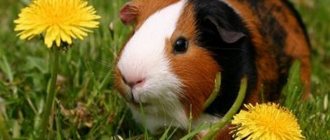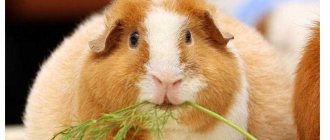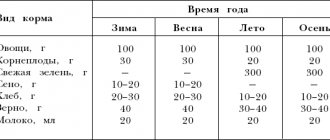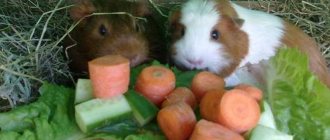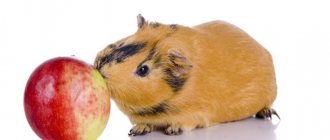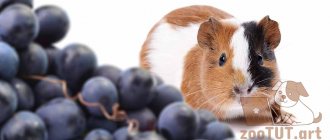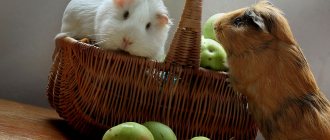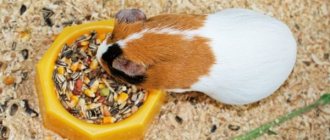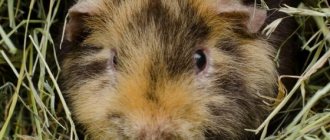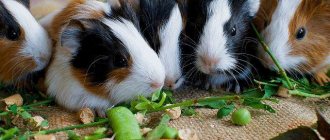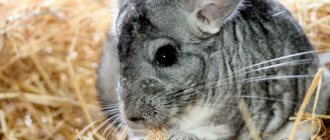A guinea pig's diet primarily consists of grass hay and high-quality guinea pig pellets or dried food. They also need a good supply of water and a selection of fruits and vegetables to ensure they have a healthy and balanced diet that meets their nutritional needs. Sometimes their owners like to treat them to foods intended for humans, such as bread. However, not all human food is safe for guinea pigs. So, can guinea pigs eat bread?
Green feed
In addition to hay, the animal loves to eat green food.
They minimize the risk of developing diseases of the digestive system and saturate the body with useful substances. Guinea pigs can eat celery, mint, spinach, basil, dill, parsley and arugula. They eat tansy, yarrow, chamomile, plantain leaves, clover, young sedge and dandelions with appetite. It is also recommended to introduce sprouted grains, cilantro, carrot tops, turnips and beets into the guinea pig's diet.
Not all greens are good for feeding your pets. They should not eat a lot of lettuce leaves. Some of them, in particular watercress, have a diuretic effect and irritate the respiratory tract.
Most wild plants are poisonous and unsuitable for animal feeding
Therefore, they must be collected extremely carefully. For safety reasons, guinea pigs should not be fed unknown plants.
For the same reason, animals are prohibited from eating greens purchased at the market.
If it has been treated with insecticides, it can cause severe poisoning and even death of the pet.
Physiological features of guinea pigs
No matter how “domesticated” animals are, the best way to preserve their health is to bring their living and nutritional conditions closer to those of their wild counterparts. Cereal plants can be cultivated or wild, each of them contains starch, but there are still differences in quantity. Therefore, in the natural environment such food is acceptable. Plus, wild animals move more and spend a lot of energy getting food, which means they require more energy.
Let's figure out why a large amount of carbohydrates is dangerous for these pets. Once in the body of pigs, starch is broken down into glucose, an easily digestible monosaccharide and source of energy. But such animals cannot absorb much of it, and the remainder, being in the digestive system, leads to fermentation. This creates favorable conditions for the development of harmful microflora, manifested by bloating and diarrhea.
Another feature is the need for a constant supply of food. If your pig is starving, stagnation may occur in the intestines. Therefore, there should always be food in the feeder (hay, grass, vegetables, fruits). But if it is a high-carbohydrate food, then the excess is deposited in the form of a layer and leads to obesity.
Paying attention to the physiology of these furry animals, we can conclude that it is possible to give guinea pigs bread, but not all types and in a certain quantity
What is allowed
Bakery products are included in the diet of animals, but not all of their types. Among the permitted baked goods are:
Black bread
It is baked using rye flour, which is healthier than wheat flour. Pigs happily eat pulp and crusts, but the owner must remember that even healthy bread is given in quantities of up to 30 grams per day. If the dose is exceeded, the pet will experience bloating and constipation.
Crackers
Dried slices of stale bread are excellent for sharpening the animal's teeth, but even this food is given in the amount of one small thin piece. In no case should crackers contain sugar, vanilla, cinnamon or other additives. To prepare crackers, take a stale loaf or rye pastry.
Bread
If these products include bran, sesame or flaxseeds, and do not contain salt, sugar and fat, then such a product will be useful for your pet, but only in moderation.
Even the permitted types of bread play the role of a delicacy, and not the basis of the menu.
Other bakery products
Experts do not recommend giving your pet buns, crackers, pasta, cookies, crackers, toast and much more that are tasty and nutritious for humans. In most cases, these products contain various additives, are subject to heat treatment and only cause harm to the rodent’s digestive system.
Crackers
There are exceptions. Crackers are one of the most harmless products listed above. Of course, if we are not talking about store-bought crackers with various spices and additives.
Crackers will not ferment in the stomach and will serve as a tasty treat for your pet. But only in small doses: no more than 30 grams.
Other products
Pigs eat almost everything
In general, these rodents can be called omnivores. But not all products are recommended for use by rodents.
Milk
Many people are interested in whether guinea pigs can have bread, and whether guinea pigs can have milk. Rodents in the wild do not eat these products, since it is not possible to obtain them. Accordingly, they are of no value to their body. Moreover, the rodent body is not able to break down lactose. Therefore, drinking milk can cause serious health problems. Milk can be given in small quantities only to young animals.
Bread
Bread, especially fresh bread, is also not recommended for furry pets. It causes bloating. We give crackers in small quantities. It is better to use black bread to make crackers.
Seeds and nuts
As for whether guinea pigs can eat nuts and a variety of seeds. There are no restrictions on these food products. But their consumption leads to obesity. Therefore, we include nuts and seeds in our diet in small quantities. Of the nuts, preference should be given to peanuts and walnuts. Almonds are not prohibited. As for seeds, you should give preference to pumpkin seeds. Or you can give a mixture of sunflower and pumpkin seeds. We first remove the husks from all the seeds.
Cereals
Of all the cereals that can be seen on store shelves, only oatmeal, ground into fine cereals, can be included in the diet of rodents. But you shouldn’t pamper your pets with them often. If oats are present in the diet, then this is quite enough. It is strictly forbidden to give boiled porridge to rodents. It will cause digestive problems. After all, in nature they eat only raw foods.
Is it possible to give crackers?
Is it possible to give crackers? ¶
When our back teeth outgrew our back teeth, before leaving, the vet said to give them a cracker so that the teeth could be ground down. It’s just that both the boy and the girls have mineral pebbles in their cage, but the boy periodically gnaws, and the girls don’t care about him. Well, I put a cracker in both of them, but the boy doesn’t care about it, but the girls gnaw so that everything in the apartment is shaking )) I just saw some controversy about crackers somewhere, but I don’t remember where. What do you say? Is it possible or not?
Article on the topic: Can guinea pigs eat avocado, pineapple, mango and kiwi?
Is it possible to give crackers? ¶
From: Ariana - April 15, 2011 1:02 pm
You can have dried white or black bread.
Is it possible to give crackers? ¶
You can have dried white or black bread. Well, it’s clear that it’s not Kirieshki)) I give them a dried loaf, they gnaw so that the cage shakes)
Is it possible to give crackers? ¶
From: len4ik - April 15, 2011 6:50 pm
Just any crackers are weight gain.
For me, let them eat more hay. It also grinds teeth well, and has more benefits for gastrointestinal tract.
Is it possible to give crackers? ¶
Just any crackers are weight gain. For me, let them eat more hay. It also grinds teeth well, and has more benefits for gastrointestinal tract. Well, no one took the hay from them; they eat it just as actively as they always did.
Is it possible to give crackers? ¶
From: POLYA - April 15, 2011 19:50
Well then, less vegetables. They won't eat my crackers at all! The fact that they eat hay is good. Then why are there problems with teeth? Do they eat the food well?
Is it possible to give crackers? ¶
Well then, less vegetables. They won't eat my crackers at all! The fact that they eat hay is good. Then why are there problems with teeth? Do they eat the food well? The boy had problems with his teeth, he lives separately. He doesn’t eat crackers at all, sometimes he chews on a mineral stone, but now it’s been about a week since I see him chewing on it. And the girls in the other cage don’t eat pebbles, their teeth seem to be ugh ugh ugh, everything is fine, but the doctor said to give him crackers. He also eats hay normally. There’s just no way we can cure the guy, I’m now better off for prevention and I’ll give it to him
Article on the topic: What to feed a guinea pig at home: food and a list of foods that can and cannot be included in the diet
why are there fewer vegetables?
Is it possible to give crackers? ¶
From: len4ik - April 16, 2011 6:27 pm
why are there fewer vegetables? What was meant was to eat more hay and sharpen his teeth. And they just lick the pebble. This does not affect tooth wear.
If teeth grow back, this is not a one-day problem. Read the topics: trim every 10 days, then treat for a long time until the pig itself begins to eat properly.
It is necessary to be interested in roughage and hay so that the teeth work
.
And if he still doesn’t eat crackers, as you write, then why give them - spoil his appetite?
Is it possible to give crackers? ¶
What was meant was to eat more hay and sharpen his teeth. And they just lick the pebble. This does not affect tooth wear. If teeth grow back, this is not a one-day problem. Read the topics: trim every 10 days, then treat for a long time until the pig itself begins to eat properly. It is necessary to be interested in roughage and hay so that the teeth work. And if he still doesn’t eat crackers, as you write, then why give them - spoil his appetite? Only girls have crackers, they haven’t been sick, but they really like it, they eat everything well.
And the boy has a pebble and I wouldn’t say that he licks it, he gnaws it so noisily that when I heard this terrible grinding sound, I ran to see what was happening there. And I don’t give him a cracker anymore. Only for girls
Is it possible to give crackers? ¶
And for my teeth I buy special food Vitacraft Bits and Kavia Pro. My cracker also loves to chew, especially with raisins.
Article on the topic: Hay for guinea pigs: which is better, how to prepare and give
Is it possible to give crackers? ¶
The cracker will not help when grinding the rear ones, it is only for the front ones. And for the hind ones there is more hay and twigs
Is it possible to give crackers? ¶
Yes, crackers made from regular bread, sometimes with bran - not often.
Feeding pregnant pigs and newborn piglets
Pregnant and lactating females need a complete and well-balanced menu. Their usual diet is supplemented with rosehip infusion, succulent food, vegetables and fruits. Pregnant females also need vitamins for their guinea piglets.
Although babies are born with teeth, at first they feed on their mother's milk. True, this does not prevent the cubs from eating “adult” food. Therefore, their cage should always have fortified food enriched with proteins.
Guinea pigs are herbivorous ornamental animals that eat mainly hay, vegetables, herbs and fruits. If they are fed correctly, they will greet their owners with joyful squeaks for many years.
Feeding regimen and technique
Healthy adult guinea pigs are fed twice a day, while pregnant guinea pigs and babies are fed up to four times a day. With two meals a day, rodents are offered succulent food for “breakfast,” and grain or a grain mixture and greens are prepared for “dinner.” In winter, greens are replaced (or supplemented) with hay.
It may be an unpleasant surprise for first-time owners to learn that pigs (even piglets!) eat their own feces. But this is how nature has established it: it is in this unusual way that colonies of beneficial bacteria enter the pig’s body. If you do not allow your pet and her cubs to eat your litter, this will immediately have a negative impact on the health of the animals.
The principles of proper feeding of guinea pigs are:
- Gradual change in diet. Violation of this principle can lead to disruption of the animal’s digestive system.
- Compliance with feeding hygiene rules. These rules include removing food residues, regularly washing the feeder and drinking bowl, and washing vegetables, fruits, and leaves.
- A hearty dinner is required.
- The presence in the diet of a sufficient amount of vitamin C, which the animal’s body cannot synthesize. A lack of this vitamin can cause paralysis in rodents! For an adult, the norm of vitamin C per day is 15 mg per 1 kg of body weight. When pregnancy occurs, this rate doubles.
Daily ration
Once the owner decides what to feed the guinea pig, he should pay attention to feeding standards. Here is an approximate daily diet for an adult from the pig family:
Here is an approximate daily diet for an adult from the pig family:
| Menu Component | Summer | Autumn | Winter | Spring |
| Fresh greens | 0.040 kg | 0.030 kg | ||
| Hay | 0.010 kg | 0.010 kg | ||
| Raw vegetables | 0.120 kg | 0.120 kg | 0.125 kg | 0.125 kg |
| White bread | 0.020 kg | 0.020 kg | 0.030 kg | 0.025 kg |
| Hard food | 0.040 kg | 0.040 kg | 0.040 kg | 0.040 kg |
Some veterinarians recommend feeding guinea pigs milk in the amount of 0.025 liters per day, regardless of season and age. Let us beg to differ with them. Rodents should not be accustomed to milk, because nature has not provided their body with enzymes that help digest dairy products.
You should be careful about your pet, because the given nutritional standards may vary depending on:
- degree of animal activity;
- health conditions;
- age.
So, pregnant females need more food. Therefore, the volume of food eaten for them increases by 30%.
Sorry, there are no surveys available at this time.
Bread products: good or bad?
On forums, there are quite often discussions on the topic “is it possible to give guinea pigs bread and other baked goods.” People share their experiences and impressions, but the majority is inclined to believe that such food is not the most necessary for the animal.
If you look at the table of foods not recommended for pigs, bread is at the very beginning of the list. The phrase about contraindications wanders from article to article: bread, rolls, cookies... This is by no means a replacement for grain feed.
What kind of bread is there?
The type of bread is important. You can name several of them at once:
- What type of bakery products is right for your pet? Let's find out! black;
- white;
- yeast;
- yeast-free;
- fresh;
- dry;
- stale;
- with and without additives.
It is not recommended for all people, and even less so for rodents. Poorly digested, such bread ferments in the stomach for a long time, causing bloating and generally deteriorating health. The same can be said about white bread.
It is forbidden! And if so, which one and how much?
One of the tables suggests such amounts - from 10 to 30 grams per day (depending on the time of year). This is against the background of a large number of vegetables.
There is an opinion that it is, in principle, possible to feed a guinea pig bread, but in small portions and extremely rarely. By the way, this “permission” is accompanied by a caveat: they say, if you do not want your pet to have problems with digestion and constipation, then it is better not to do this.
Among the permitted ones are black stale bread, especially with seeds, or crackers, or a loaf dried in a toaster. It is good if these products are enriched with vitamin C or contain bran.
Rusks - they are good for a rodent's teeth - are allowed to be given not purchased ones with spices and additives, but homemade ones. And yet, it’s also better not to overdo it.
Among the general “bread” prohibitions, there is also a special one - you cannot:
- It is not recommended to treat rodents with bread. buns,
- sweet crackers,
- salty breads,
- fatty toasts,
- crackers,
- pasta,
- cookie.
Regarding the last position, a reservation can be made: if a little and only bland dietary.
It makes sense for new guinea pig owners to remember a simple truth: what is tasty and healthy for a person can be destructive for a pet. Before you put into his cage something that you just gnawed yourself, you should carefully study what the pig can and needs, and what it is better to do without.
The digestive system of guinea pigs is no different from their “wild” counterparts. Domestic rodents need the same foods and microelements as in natural conditions. Can guinea pigs eat bread, crackers and other baked goods? Let's try to figure it out.
What about banana peels?
Often, owners give a piece of this delicacy to their pets along with the peel. However, you shouldn't do this. Of course, banana is a plant food, but suppliers treat the fruit with wax, ethylene and chemicals so that the product retains its presentable appearance longer.
And during cultivation, various nitrates and pesticides are used to increase the rate of growth and ripening. All these Negative elements accumulate in large quantities in the peel. If they get into the animal’s stomach, then you will not be lucky enough to avoid disastrous consequences.
Therefore, it is important to remove the skin and soft tissues from the fruit before treating your pet with a healthy treat. It is also worth pre-processing an unpeeled banana: wash it thoroughly and scald it with boiling water.
Rules for feeding guinea pigs:
- It is recommended to feed at the same time, which the animals quickly get used to.
- There is no need to give too much food, and it is better to remove uneaten leftover food from the cage (except for hay).
- Green food, vegetables and fruits must be fresh.
- Hay and/or grass should be available to pigs at all times.
- Fruits and vegetables should be thoroughly washed, but not peeled. It is better to peel sweet peppers, as the skin is difficult to chew.
- Lettuce leaves absorb harmful substances, so it is recommended to rinse them thoroughly and dry them.
- The water in drinking bowls must be changed daily.
- From time to time you can give your pigs something to chew on.
What to feed your favorite rodent
Organizing food for guinea pigs at home is much more difficult than it might seem at first glance. It must be balanced and contain all the necessary substances. In nature, rodents take care of themselves and usually easily find exactly the food they need. But in a cage, their diet is very limited, so the owner must take on these responsibilities. Try to ensure that the choice is large enough so that your pet can easily find products containing the vitamins he needs.
Vegetables, fruits, greens
These juicy and tasty foods should definitely be included in your pet’s diet. However, try to give them only exclusively fresh. Some experts even recommend giving up those products that are imported from afar. They are usually sprayed with various chemicals for better storage. If they cause harm to humans, it is small. But the guinea pig is a very gentle creature, sensitive to harmful substances. Therefore, such food may well cause them much more harm than good.
In addition, peppers and tomatoes sold in supermarkets in February hardly contain any useful substances - they are often grown with artificial fertilizers.
The following fruits, vegetables and greens should be included in your diet:
- cucumbers,
- tomatoes,
- Bell pepper,
- carrot,
- cabbage (little by little),
- zucchini,
- beet,
- pumpkin.
Serving Size
There are three apple-related factors to consider when feeding your guinea pig apples:
- High sugar content;
- A large amount of vitamins;
- High concentration of acids.
It is better to cut the fruit. All these components, if contained in excess, can lead to digestive disorders, irritation of the mucous membranes and deterioration of the pet’s condition.
In this regard, you should feed your guinea pig fresh apples no more than three times a week. Moreover, it is worth giving it 2 - 3 slices, depending on the size of the fruit.
Dried fruits can be given in a bowl - every day in the morning, 3 - 4 slices.
But you cannot collect these seeds, store them separately for a long time and pour them out to your pet by the handful. The fact is that the skin of the seeds contains cyanic acid. Its concentration increases over time, making them poisonous. A large number of seeds, especially after long-term storage, lead to serious poisoning of the body and even the death of the pet.
Thus, a guinea pig can be fed fresh apples three times a week, and dried apples every day in the morning. Do not give soaked or compote-boiled apples. Apple seeds can only be given from fresh fruit in a few pieces; the seeds cannot be collected and stored separately, as extremely toxic cyanide acid accumulates in them.
How to give berries for the first time
The animal will gladly eat the offered treat in any quantity. She will happily eat 5-7 berries at a time, but this is an unacceptable amount. You don't want to harm your pet's health.
- Select ripe fruits, without rot or signs of wilting.
- Pour boiling water over them and then rinse with filtered water.
- Remove the twig with the pit.
- Divide the fruit in half and give one part.
- Monitor your pet's condition for 3 days. If there are no changes in behavior, the animal has normal stool, you can safely introduce berries into the diet.
If this is your first time feeding your guinea pig cherries or cherries, you will need to watch for side effects. If you notice any unusual behavior, it is advisable to stop giving your pet berries.
Can guinea pigs eat bread?
It is indispensable in our daily life. It comes in different types, black and white, with and without yeast, dry and stale, with and without additives. Recently, it has even been baked from artificial wheat. All this is of great importance.
Fresh bread is strictly contraindicated for guinea pigs. It should not be given, as it is poorly digested and remains to ferment in the stomach. White bread also often leads to bloating and worsens overall health.
In principle, if you feed your pig bread quite rarely and in small portions, then it is possible. But, if you do not need your pet to suffer from digestive problems and constipation, then it is better to abandon this idea.
What bread should you choose for your diet?
Pigs are herbivores. Wheat is a herbaceous plant, but bread is not a plant, although it consists of the same grain. It is subjected to heat treatment, spices, flavor enhancers and other additives are added to it. It does not help in grinding teeth, since it softens in the oral cavity, and in the stomach it generally turns into mush and can cause harm. So what kind of bread can you feed your guinea pig?
Black
It is considered less harmful when compared to white. But in both cases, the composition often contains yeast, which is practically contraindicated for guinea pigs. Because of them, real fermentation can begin in the animal’s stomach.
White
White bread, especially fresh bread, is strictly prohibited. When it mixes with saliva and gastric juice, it turns into a dense lump, which threatens at least indigestion: it takes a long time to digest, causes bloating and creates discomfort and a feeling of heaviness.
Yeast
It should be completely eliminated from use. It only creates an unpleasant sensation and a feeling of false satiety.
Fresh
It is prohibited. It is harmful even for people, but for a small pig, for which bread is not a natural food, with a small stomach volume and a different structure, it can become dangerous.
Stale
Preferred choice. But you shouldn’t feed it to your rodent; follow the dose if you don’t want your pet to have health problems. Regular overeating of bread by guinea pigs can lead to obesity.
Supplements in the form of seeds, nuts and other products will not harm the animal if you remember in moderation. We are not even talking about grams, but the number of pieces: a couple of nuts, or raisins. Not more!
Guinea pig nutrition: general rules and recommendations
Your pet's daily menu should be balanced and varied.
It is very important to choose fresh and natural foods for feeding, which contain large amounts of essential vitamins and substances beneficial to the animal’s body.
You can purchase food for your animal both in veterinary stores and in regular supermarkets, choosing vegetables, herbs and fruits grown without the use of large amounts of chemicals and pesticides. In the summer, you can collect succulent grass yourself in the forest, in places remote from roads.
Important. A guinea pig needs to be fed at least 2 times a day. If a pet remains hungry for 18 hours or more, its health can be greatly undermined, and even death is possible.
If a pet remains hungry for 18 hours or more, its health can be greatly undermined, and even death is possible.
Compliance
One of the main rules in feeding a pet, which should be strictly adhered to from the first days of the animal’s appearance in the house, is the prohibition of overfeeding.
Overfeeding leads to overweight and obesity, which, in turn, negatively affects the health of the animal's heart and liver.
Important. Clean water, as well as grass, hay or grain, must be present in the pet’s cage at all times.
Mode
It is recommended to give food to the animal at the same time, thus establishing a feeding schedule. Standard feeding is recommended in the morning, afternoon and evening.
Change of feed
A radical change in food is quite stressful for the animal, which can harm its health. If there is a need to change food, it is best to do this in stages, gradually adding some new food to the usual main product.
New products
When introducing new, unusual foods into the animal’s diet, you should very carefully monitor the pet’s condition. The first portions of new food should be minimal.
If the animal begins to have any reactions, including with stool, the new product must be completely excluded from the diet.
Guinea pigs should only be given fresh food.
Food quality
Much attention should be paid to the quality of the food served: fresh vegetables, herbs, fruits and berries must be ripe and juicy. Before giving such food to an animal, the product must be thoroughly washed with running water. If the animal is given ready-made food, it is necessary to check the expiration date and store it in accordance with the instructions on the packaging
If your pet is given prepared food, check the expiration date and store it according to the directions on the packaging.
Important. It is strictly forbidden to give rotten, spoiled or moldy food to your pet.
Availability of water
Despite the fact that the animal receives a large amount of moisture from juicy, ripe vegetables, a drinking bowl with clean water should always be available. In the summer, your pet may need more water than in the winter.
Important. Water for the animal should be bottled
Cleanliness of dishes
The pet's home, as well as its dishes, must always be kept clean.
The water in the drinking bowl should be changed regularly, and the drinking bowl itself should be cleaned using a special brush. The same applies to all bowls and plates with food, especially dishes on which fresh vegetable or fruit food is served.
Dishes must be washed thoroughly without using dishwashing liquids. If necessary, plates and bowls can be washed with water and regular baking soda.
The bowls themselves can be ceramic or plastic.
Green feed
Green food consists of lush field or meadow grass: sage, chamomile, burdock, plantain, clover, etc. This product is a particularly important element in the diet of a guinea pig, so it is necessary to provide the animal with fresh herbs all year round. Spinach leaves or dill stalks are perfect.
Hay and branches
Hay and branches are so-called roughage or dry food, which helps maintain your pet's digestion and also wear down teeth.
The hay must be fresh and clean, free from foreign impurities and dust. Twigs for guinea pigs can be taken from willow, birch, linden, rowan, alder, pear or apple.
Important. It is forbidden to give the animal citrus and coniferous branches, as well as branches from trees whose fruits have hard seeds: peach, apricot, cherry, sweet cherry, plum, etc. On average, pigs eat 2-3 times a day.
On average, pigs eat 2-3 times a day.
Read with this
Vitamins and minerals
The fact is that the body of guinea pigs does not contain a special enzyme, I-gluconolactone oxidase, which is involved in the synthesis of vitamin C from glucose. It is because of this circumstance that your pet is not able to get this incredibly valuable vitamin from regular food. Your task throughout the animal’s life is to regularly provide it with ascorbic acid.
With a lack of vitamin C in the body of an adult, the following pathologies can occur (most often manifested as symptoms of scurvy):
- retardation of movements, visual lameness (although the animal did not fall), decreased activity;
- lack of appetite, external lethargy and indifference to what is happening;
- diarrhea, swelling of joints;
- there is blood under the skin and in the secretions;
- bleeding and falling out teeth;
- the animal looks disheveled, the fur is crumpled, and may even fall out.
In summer, the diet should be replenished with plenty of fresh greens, plants, leaves and stems, not to mention fresh vegetables and fruits. Most of these fruits contain ascorbic acid. As for the cold winter period, it is necessary to gradually add synthetic ascorbic acid to the diet. Pregnant females, older individuals and young animals need an increased dose of vitamins, as well as an increased amount of food.
For an adult, you need at least 15 mg of vitamin C per kilogram of weight daily; for pregnant women and young animals, approximately 40-45 mg per kilogram of weight should also be given every day.
The greatest amount of vitamin C is found in the following vegetables, plants and fruits: tomatoes, broccoli, apples, nettles, burdock, as well as raspberry and currant branches (always with leaves), dandelion, basil, mint, parsley, cabbage, kiwi. Remember that many of these plants should be given in strictly limited quantities.
Almost all of the listed vegetables and fruits can be found in the public domain in the summer and autumn, which is why preference should be given to these products in the summer rather than synthetic vitamins.
Be careful when choosing a place to collect all the necessary herbs (in case you do not trust herbs from pet stores). Try to choose areas far from factories, roads and industrial enterprises to collect them. The greatest danger is in grass collected from parks and city lawns. Typically, such plants are treated with harmful chemicals against parasites, which will also negatively affect your pet.
There are only two problems with such capsules:
- you will not recognize their composition in any way due to the fact that the mixture is homogeneous; it is impossible to determine the composition, as well as to detect the presence of sawdust and dust, which sellers love to add to capsules;
- capsules are intended for long-term use, they can be stored for a long time in one specific place, and ascorbic acid, after 3 months from the date of production, begins to gradually deteriorate and loses its beneficial properties.
When purchasing ready-made feed mixtures, you should always check the production date. To ensure that the food is fresh and does not spoil, it should be stored in a dry, dark place with low humidity. It is under such conditions that ascorbic acid will slow down the decomposition processes.
Grain feeds and treats
Guinea pigs are unpretentious eaters; their main food is plant leaves and grains, so feeding your little pet is not difficult.
The main thing is that the diet contains the required amount of vitamins and nutrients; also try to create conditions for the animal to play, otherwise, if there is a lack of exercise, it will become fat. Any animal sometimes needs to be rewarded with treats; for guinea pigs, the best sweets are juicy fruits, apples, strawberries, tomatoes, grapes, pears. In winter, guinea pigs must be given hay. Legume-cereal and bean hay are of the greatest value; it is also worth taking care of the preparation of “vitamin herbs”: clover, alfalfa, nettle. This is an excellent food for young pigs and pregnant females. Do not collect grass near roads and in polluted areas; swamp hay is not suitable for feeding pets. Hay can be included in the pig’s diet 1.5-2 months after haymaking; it must be thoroughly dried; do not give the animals rotten or blackened hay - it should smell pleasant and be fresh.
Sudanese grass, china, lupine, sweet clover, alfalfa, clover, sainfoin can be given as greenery. In early spring, this can be winter rye, wormwood, burdock, sedge, young shoots of willow and willow. In the first half of summer it is red clover and forbs (burdock, yarrow, plantain, dandelion, camel thorn, tansy, heather, wheatgrass, sage). It is not recommended to give dandelion and wormwood frequently.
Nettle leaves are very useful for pigs - they contain ascorbic acid, carotene, protein, starch, carbohydrates and useful organic acids. This plant is used for the prevention and treatment of vitamin deficiency. You can dry nettles and add them to your pigs' food as powder. Do not dry nettles in the open sun - they lose their nutrients, preferably in a barn or attic. Before giving fresh herb, it is advisable to keep it in boiling water for a couple of minutes and then chop it thoroughly. Plantain is also useful - they contain citric acid, potassium, emulsin, vitamins B and C, and carotene. And the seeds contain fatty oil, oleic acid, carbohydrates.
Poisonous herbs for pigs are such herbs as cory, celandine, sow thistle, marsh rosemary and marigold, fern, night blindness, wrestler and other herbs.
Melon
The same goes for melon. This vegetable is given from your own garden or purchased in season. It is also not recommended to give melon frequently; it is very sweet and can contribute to the development of diabetes.
We tried to consider in as much detail as possible and give answers to the question “What vegetables can guinea pigs eat?” As you can see, most vegetables are not only possible, but also should be given to guinea pigs. The most important thing is a properly formulated and balanced diet for your pet, including products grown without chemicals. To keep your guinea pig healthy and cheerful, stick to proper nutrition and your pet will thank you with its playful behavior and healthy appearance.
So, we have dealt with the question of what vegetables can guinea pigs eat, but we described whether your pet can eat grass in , perhaps you will be interested in this information.
The guinea pig is a very interesting pet that needs good care and company. The diet should include food that they consume in the wild. This is the only way to maintain strong immunity and normal functioning. You need to know what guinea pigs eat before you buy one.
Proper nutrition is extremely important and the health and life of the animal will depend on it. For starvation, 1–2 days without food is enough
Vegetables
Can guinea pigs have radishes?
It is permissible to use only radish tops. The root vegetable contains essential oils that can cause irritation to the mucous membranes and respiratory tract of the animal. The vegetable also causes bloating. Therefore, it is not recommended to give radishes to pigs.
Can guinea pigs eat celery?
Celery can be given in any form - stems, leaves, roots. This vegetable is included in many dry food for rodents. Celery is enriched with vitamins B, PP, E, C, A and contains phosphorus, zinc, potassium, calcium, iron and magnesium. Before eating, celery must be washed thoroughly, especially the root.
Can guinea pigs eat tomatoes?
Ripe fruits can be included in the food. Tomatoes are well absorbed by animals and contain vitamin C and carotene, which are beneficial for their body. Green tomatoes contain solanine, which can negatively affect your pet’s health.
Too many tomatoes in an animal's menu can cause loose stools.
Can guinea pigs eat cabbage?
Cabbage can be included in the animal's diet. Cabbage contains many vitamins and other substances necessary for pigs:
- ascorbic acid;
- B vitamins;
- vitamins of the PP group;
- folic acid;
- sulfur;
- calcium;
- potassium;
- phosphorus;
- amino acids;
- microelements.
The vegetable is able to keep the animal’s fur in excellent condition and strengthen its immunity. The top dried leaves should be given. It is preferable to feed guinea pigs Chinese cabbage and broccoli. White cabbage can cause bloating.
Can guinea pigs eat potatoes?
Green and sprouted potatoes are contraindicated for guinea pigs. Raw vegetables can be given occasionally, cut into small pieces. Boiled potatoes can be offered to your pet separately or added to grains and other foods.
The vegetable contains solanine, which can harm the health of the animal if the pet eats too many potatoes. The pig will become passive and catch cold quickly.
Can guinea pigs eat beets?
Beetroot contains many substances useful for animals: vitamins C, A and B, potassium, magnesium, phosphorus, iron. In excess, the vegetable contains fiber, so it acts on the animal’s body as a laxative. Store-bought root vegetables may contain nitrates, which are very harmful to the small body of guinea pigs. It is better to offer your pet homemade crops. The composition also contains a large amount of oxalic acid, so it is better to limit the consumption of this product.
It is recommended to give beets starting from 2 months; they are especially useful in winter and spring, when there are no fresh vegetables. The daily dose should not exceed 200 g, and it is better to exclude beets from the diet of pregnant and lactating pigs so as not to provoke an upset stomach. Beets turn stool and urine red, so if your animal has eaten them, don’t be alarmed by such changes.
Can guinea pigs eat pumpkin?
Pigs can be given all varieties of pumpkin that humans eat. For the digestion of herbivorous animals, such a product will be familiar and useful. Pumpkin contains vitamin C, calcium and phosphorus necessary for rodents. It should be borne in mind that this low-calorie vegetable will not be able to saturate the pig completely, so it is better to give pumpkin to guinea pigs as a treat.
Can guinea pigs eat bell pepper?
Another storehouse of ascorbic acid is bell pepper. Before use, the vegetable must be thoroughly washed and chopped, and the seeds removed. It is better to give the product together with dry food.
Green peppers containing solanine should not be given to animals, as should peppers in the form of hot seasonings. Spicy foods will damage the mucous membranes.
Can guinea pigs eat cucumber?
Cucumbers don't have as many nutrients as other vegetables. You can offer your pet a cucumber. The vegetable can harm your pet's health by causing digestive problems only if consumed in large quantities.
Can guinea pigs eat zucchini?
Zucchini is suitable for the diet of guinea pigs. They contain small amounts of vitamin C, calcium and phosphorus. It is better to prefer young vegetables; they can be given along with the peel, cut into crowbars.
Vegetables and root vegetables
Leaves and shoots of bushes, trees, as well as pieces of melons and vegetables can be used as green food for guinea pigs. You can give rodents lettuce leaves, carrot and potato tops. A lot of nutrients are contained in young corn, spinach, and kale - they can be stored frozen for several months.
Such feeds are introduced in autumn and winter, when there is no green grass. You can also give the animals pieces of carrots, turnips, turnips, and sugar beets. Rutabaga is also useful - it is a storehouse of glucosides, fiber, ascorbic acid, calcium, potassium, iron and phosphorus. Sometimes you can give your pigs potatoes - they contain fiber, carotene, vitamin C, B1, B2, B6, PP, K. Young tubers contain the most useful substances. You can also give your pigs zucchini, cucumbers, and tomatoes. But you should avoid cabbage and other cruciferous plants - they disrupt the digestion process of pigs.
What can cause excessive consumption of bread?
The cereals that these animals feed on contain starch. It contains the necessary sugars - “fuel” for the rodent. Excess carbohydrates can lead to intestinal problems: diarrhea, bloating, development of harmful microflora.
This is where the harm of replacing grain with bread lies: there is much more starch, and therefore carbohydrates, in bread, and the stomach of guinea pigs is no longer ready for this.
Their digestive system is designed to digest food regularly. To ensure this process, coarse fiber is needed, which is provided by grain products, as well as hay, grass, vegetables and fruits.
For some time the consequences will not be noticeable, but gradually the side effects will increase: flatulence, bloating. Excessive eating of bread can lead to serious consequences in the body of a guinea pig: disruption of the digestive tract, development of fungi and other gastric disorders.
Strictly prohibited species
Guinea pig breeders unanimously claim that the following products should be excluded from the rodents’ diet:
- buckwheat;
- corn grits;
- millet;
- buckwheat.
Such restrictions are due to the limitation of the animal’s physical activity. These cereals contain an excess of carbohydrates. These, in turn, are converted into fat deposits. Getting into the internal organs, fat contributes to the formation of problems with the gastrointestinal tract of the rodent. These grains can also provoke fermentation, causing bloating and discomfort.
Products from the human table are absolutely not suitable as food for guinea pigs. It is worth remembering that pigs are herbivores. Hence the strict ban on protein products: meat, fish, eggs, dairy products, cheese, butter.
And sweets, chocolates, sugar, marmalade and the like are strictly prohibited for consumption by rodents.
A separate article is vegetables grown in greenhouses. As a rule, when growing them, nitrates, pesticides and other chemically active substances are used. All this can cause irreparable damage to your pet's health.
And under no circumstances should you treat the animal with salty and sour foods - citrus fruits, mustard, sorrel, garlic, onions, marinades and pickles.
For a long and happy life for your guinea pig, you must first create the right diet. In this case, caring for your pet will not be difficult. A beginner pet owner who is unsure of his abilities may well use ready-made mixtures. In this case, you should not skimp and it is recommended to purchase them from trusted manufacturers. When choosing a product, you should consult a specialist. The range of ready-made mixtures for guinea pigs is wide, however, despite all the variety, they have approximately the same content of vitamins and minerals.
Over time, it is permissible to diversify your pet’s diet, creating a complete rodent diet.
Purchased food
Some guinea pig owners, not wanting to rack their brains over a balanced diet, prefer to buy ready-made formulas. In theory, they are good because they contain all the necessary minerals and vitamins.
Alas, in practice it does not always work out this way. Often the package simply contains seeds and cereals that contain practically no vitamins. You can feed guinea pigs with such mixtures, but not for months, or regularly enrich the diet with additional food.
What not to feed guinea pigs
Prohibited foods that should never be fed to these animals include:
- all citrus fruits;
- sweets and confectionery;
- fresh baked goods;
- eggs;
- meat in any form;
- dairy products;
- fish products;
- mushrooms;
- porridge;
- spaghetti and pasta;
- smoked and pickled products;
- onion;
- cheese;
- rice;
- beans;
- potatoes in any form;
- all seasonings and spices;
- honey.
In addition, guinea pigs are prohibited from eating house plants and flowers.
In small quantities, you can treat your pet to bell peppers, tomatoes, ripe avocados, cauliflower or white cabbage, banana, melon, watermelon, blackberries, sea buckthorn, rowan, gooseberries or cranberries.
Results
In conclusion, I would like to say that not everything that your guinea pig eats will be good for it. Do not try exotic products on her. If you don’t know whether your guinea pig can eat this or that product, it’s better not to feed it. A rodent in captivity cannot distinguish between products that are not healthy for it and therefore will eat everything you offer. On forums you can often see messages that some owners' guinea pigs eat almost all the foods on the prohibited list. But do not experiment on your pet; give him only vegetables, grass, herbs and fruits growing in our country. Believe me, without oranges, tangerines, bananas, kiwis and other harmful fruits, they will survive and live a long and happy pig life, delighting you.
« Previous entry
Forbidden food
Fresh white bread is prohibited from being included in the guinea pig's menu, as it rapidly provokes fermentation processes in the gastrointestinal tract, causing flatulence and problems with bowel movements. It is also a high-calorie product that contributes to gaining extra pounds.
Pasta is a prohibited food
Despite the fact that the animal happily eats muffins and other baked goods made from wheat flour, you need to remember that they cannot eat most dough products. These include:
- pasta in any form;
- cookies and crackers;
- croissants and filled pies;
- toasts and croutons with any fat;
- buns.
If you offer these foods to your pig, she will not refuse them, but will enjoy them with pleasure, but the consequences of such a meal will be negative. Difficult to digest foods will cause abdominal pain, constipation and deterioration in overall health. Therefore, you should not experiment with your pet’s menu.
Source
